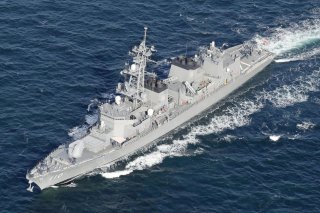Who Would Win a U.S.-Japan vs. China War? A Recent War Game Presents Some Clues.
Here's what one war game forecasted could happen.
A recent think tank wargame explores the prospect of a massive war between China and America and Japan in 2030, introducing many war-time questions about submarines, amphibious attack, surface ships and fifth-generation fighters.
According to a story in Foreign Policy, the Center for New American Security’s wargame unfolds as follows:
“…A Chinese flotilla lands 50 soldiers on Uotsuri Jima, an island in the East China Sea that is part of the Senkakus, an island chain owned by Japan but also claimed by China. Declaring a 50-mile exclusion zone around the Senkakus, Beijing deploys a ring of surface ships, submarines, warplanes, and drones—backed by ballistic missiles based on the Chinese mainland…”
Japan counterattacks, sending in amphibious warships, submarines, surface warships and aircraft-backed Marines.
Given the existing “Mutual Defense Pact,” the U.S. sends aircraft carriers and other assets to support Japan, with specific instructions not to exchange fire with Chinese forces. That does not work, according to the wargame scenario.
Therefore, war between China and the U.S.-Japan alliance ensues. By any estimation, it would be the largest engagement the world has seen in just about 100 years, and like no other in history, it would be entirely multi-domain.
A maritime engagement between the United States and China would likely incorporate a wide range of complex and dangerous variables. Initially, by 2030 the Chinese Navy is likely much larger and potentially just as sophisticated as the U.S. Navy, or at least in a position to rival American technical supremacy.
Much of the outcome of this kind of war might be decided by several distinct factors, such as the technical evolution of Aegis radar and accurate, long-range sensors. Both the U.S. and Chinese warships will be armed with massive, long-range attack weapons, so it would seem that the prevailing force would be that with the best and highest resolution sensors.
The force “out-ranging” the other with intelligence, search, and reconnaissance through aerial or surface drone sensors and sensor-enabled F-35s, might be likely to rule the day. Given this, the country with the best air support would be likely to emerge victorious, hinging upon on whether the Chinese fifth-generation J-20 and J-31 stealth fighters can equal or out-perform the F-22 and F-35. The winner of that engagement would be much better positioned to out-range and out-attack the opposing force.
Ultimately, the country with the more advanced AI-enabled sensors, long-range weapons and surface-to-air-to-undersea networking would destroy the other. Who will have better sensors and networking? Perhaps the country with superior space weapons, electronic warfare capabilities and “hardened” communications would be best positioned?
Also, whose communications would get jammed? Who has better alternatives to GPS? Who has more lower flying, faster, armed and better networked satellites? The country with this advantage could potentially destroy large portions of the opposition military from space in the initial portions of any conflict.
By 2030, satellite-fired weapons will likely be here, scalable lasers will bring unforeseen range both within and beyond the earth’s atmosphere and satellite sensor sophistication and weaponization would likely determine the victor.
Interestingly, one of the wargame circumstances described in the Foreign Policy report involved a decision to “jam” or attack Chinese communications systems as opposed to pursuing a more kinetic or direct fire option.
Also, Aegis radar and other elements of the Navy’s ship-based layered defenses would determine whether Chinese land-fired anti-ship missiles were able to successfully destroy U.S. carriers and warships.
Should the U.S. Navy succeed in engineering new, extremely sophisticated layered ship defenses with now-emerging weapons such as laser interceptors, drones and electronic warfare by 2030, Chinese attacks might be stopped. Same would be true on the Chinese side, meaning the maritime force with the best defenses would most likely have an upper hand.
Given all of these factors, sheer force size in terms of numbers of ships, provided each had several hundred, might be less significant than the technical elements of the weapons themselves.
This area of war, it seems clear, would also expectedly hinge upon air power, because if U.S. stealth fighters and bombers were able to penetrate Chinese airspace and destroy land-fired weapons, then ship defenses would have a tremendous advantage as well. Undersea war would also be decisive, as the country dominating below the surface would be in position for forward attack and clandestine reconnaissance missions.
At least initially, it is likely that the U.S.-Japan alliance would attack with the more limited goal of liberating the island chain or at least repelling the Chinese presence from the contested area of the East China Sea. This brings a potential advantage as the strategy would be to avoid a major, protracted ground war against China’s one-million strong, armored land Army.
However, if a more immediate or short-term objective evolved into full-scale war, major force-on-force land war might be unavoidable. Right now, the outcome with that would seem extremely uncertain.
Also, some kind of land-engagement, if on smaller swaths of terrain, would be expected due to amphibious assault. This presents problems and challenges for both countries, particularly in light of China’s massive uptick in amphibious assault ship construction. China is already launching its second high-tech Type 075 amphibious assault ship and is expected to have a large and dangerous amphibious fleet by 2030.
Kris Osborn is defense editor for the National Interest. Osborn previously served at the Pentagon as a Highly Qualified Expert with the Office of the Assistant Secretary of the Army—Acquisition, Logistics & Technology. Osborn has also worked as an anchor and on-air military specialist at national TV networks. He has appeared as a guest military expert on Fox News, MSNBC, The Military Channel, and The History Channel. He also has a Masters Degree in Comparative Literature from Columbia University.
Image: Reuters

